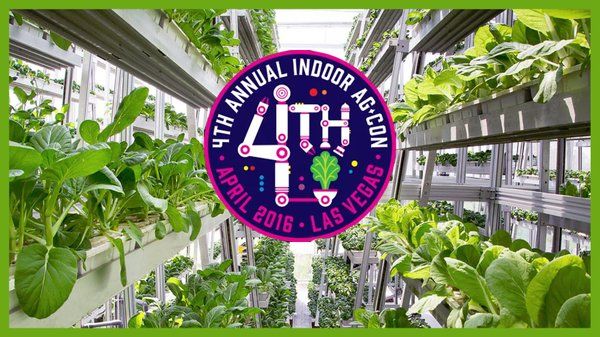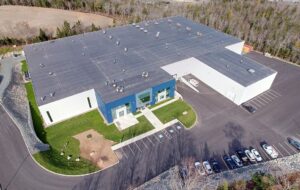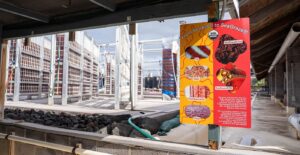Editor’s Note: Mike Betts is director of investments for AgFunder, the online investment platform for the food and agriculture technology market. Last week Betts attended the Indoor Ag-Con in Las Vegas which is now in its fourth year. Indoor agriculture has gathered pace as a sector in the US and Nicola Kerslake, founder of the event and Newbean Capital, an investment advisory firm, reported there were double the number of exhibitor’s at this year’s event than in 2015.
Here Betts gives his three key takeaways from the event.
Indoor agriculture is a much older industry than you think, which comes with challenges
The conference kicked off with Dr. Merle Jensen of the University of Arizona providing the keynote. Jensen coined the term “controlled environment agriculture” (CEA) in 1972 and his work dates back to the 1960s. Dr. Jensen is one of the original thought leaders in this space and has traveled the world in efforts to grow food in areas and ways previously unimaginable and helped to build and design “The Land” at EPCOT, Walt Disney World in the 1970s.
Greenhouses are an example of how CEA has been used for decades to grow food — primarily peppers, tomatoes, cucumbers, lettuce, herbs and strawberries, and more recently, cannabis, as laws begin to relax. Greenhouses are not fully controlled environments, but indoor agriculture facilities, where every aspect of growing can be controlled, are starting to take off as technology advances. It’s important to recognize that this industry is not brand new, but it’s evolving from several decades of knowledge and experience.
As such, it’s easier to understand that there is an existing ecosystem of incumbents for startups to learn from and interact with as they build new products. There are also many companies in other industries that see an opportunity for growth by bringing their technology to indoor agriculture production, such as automation and lighting. This is a growing phenomenon we’re seeing across the agriculture industry as a whole.
But for startups and investors looking to capitalize on this fast growing sector, it’s important to understand that the incumbent ecosystem is very closed off in nature. As many have found in archaic industries such as healthcare and other areas of agriculture, this is both an opportunity and a challenge. There are no standards for communication and integration, no APIs to connect to, and incumbents, such as Priva, have built closed systems. These incumbents may benefit from a non-collaborative ecosystem today, but you don’t have to look far at other sectors to see that this strategy won’t work moving forward. It won’t be easy for these existing players to turn on a dime, even nimble tech giants like Google struggle with this. It’s not easy rearchitect and open up a closed ecosystem, this is best done as you build a product, not after the fact. Technical debt from the old guard will be future startup opportunity.
So a challenge exists for startups in this space, particularly pure-play software companies like Agrilyst. Partnerships aren’t easy in an ecosystem like this. It’s also a big opportunity for disruption to any startup that can figure out how to build a full stack solution — which would require hardware and software in most cases for CEA — or can figure out how to build on top of a closed ecosystem — think 640 Labs, which was acquired by Monsanto’s Climate Corp.
Innovation in CEA for cannabis might be slow
“Suits started coming in a couple years ago”, said Mike Nelson, SVP at PalliaTech on stage.
Cannabis producers are still enjoying great margins for the time being, but competitive pressures will drive these down. The question is how soon? No one has a crystal ball and the development of the US cannabis industry is sure to defy traditional market and economic theories, individual states will behave very differently.
The medical research portion of the cannabis industry is likely to drive a meaningful portion of the innovation in controlled environment agriculture. Large scale facilities like the 315,000 square foot facility in Nova Scotia with a projected budget of over $34 million dollars that’s being designed by Autumn Karcey’s firm, Cultivo, will become key examples of best practices in the industry. Their approach to things like clean rooms, automation, traceability and security will likely be leading examples of how to do things and raise the bar for industry standards.
But for the growers supplying cannabis to the mass market in what is essentially a commodity — for now, until we have better traceability, strain performance data and consumer confidence in labeling — it’s pretty clear that high margins mean no incentive to innovate. When you’re selling a commodity that can marginally cost a few hundred dollars per pound to produce (on the high end) and sells for $2,000 a pound retail, there is little incentive to get more efficient and pinch pennies by adding technology or complexity to your operation.
Bottom line: innovation in CEA for cannabis will come from medical cannabis research and produce growers near term.
Jury still out on container farms
Growing food in a shipping container has been a hot topic for a while now.
There are at least six, and likely more players in the container farm space — CropBox, Freight Farms, Indoor Farms of America, Modular Farms, Growtainers and LocalRoots. For a concept with so much competition, it’s still not clear whether a container farm has reached product market fit. The addressable market today is certainly not large enough to accommodate so many players. While the concept is novel and practical on the face of it — we have a lot of these containers lying around, it’s portable, it’s a defined space making design easier, to name a few — the unit economics are still a hazy at best and whether this is a novel approach to growing food or a novelty was not resolved during the event.
One thing is clear; food needs fewer miles on it. The tailwinds behind CEA are genuine and infinitely promising in application. We see great application for technologies developed indoors to go outdoors and vice versa. Events like Indoor Ag-Con are fantastic, and the crew did a great job bringing people together. Multiple competitors in container farms on stage together, multiple insect protein farms on stage, lighting competitors on stage together, etc. It’s really good to see a bit of mixing in this space, where everyone plays so close to the chest.
What do you think? Get in touch [email protected]




